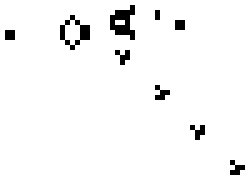 |
| Pigmen Research Council on minecraftforum.net |
The popularly-bemoaned reality of science education in schools is that it is based on rote learning of scientific output rather than actually doing science. Taking a biochemistry course, for example, is actually nothing like doing actual biochemistry (much to my delight as a grad student). Even when courses offer a lab section or a segment on experimental design, most students are taught "the scientific method." While the concept, broadly communicated as a "way of doing science" is
quite nuanced, most of us will associate the phrase with a rigid
list of steps. It's not a bad start: it emphasizes evidenced-based reasoning and the isolation of a single variable. But science doesn't really happen this way.
This version gets a bit closer by including a little loop that hints at some requirement for tenacity: if you arrive at "Hypothesis is false or partially true" you're directed to "Think! Try again" and go back to "Construct hypothesis."
Dubious value of hypotheses aside, this loop is an improvement: it emphasizes that failure is possible, acceptable, and maybe even constructive. And it really only scratches the tip of the iceberg of the quagmire of confusion and frustration that real science can present. But with limited time devoted to science education and sparse resources in the lab classroom, few students practically get to spend much time working these issues out for themselves. They are being robbed of what is maybe the most important point of science education: to keep searching and trying until you can really convince yourself (and others) that you have shown something to be true.
 |
| Pikmin, a strategy game in which the player controls plant-animal hybrids to overcome various obstacles. |
A solution may be to allow the student to perform these vital fumblings in a virtual space, rather than a real one. James Paul Gee makes an argument that video games provide children with ways to do real science in his excellent
What Video Games Have to Teach Us About Learning and Literacy:
I believe, for example, that the identity Pikmin recruits relates rather well to the sort of identity a learner is called on to assume in the best active science learning in schools and other sites. Such learning - just like Pikmin - encourages exploration, hypothesis testing, risk taking, persistence past failure, and seeing "mistakes" as new opportunities for progress and learning.
If this is true, then our six-year-old is privileged in this respect over children who do not have the opportunity to play such games (in an active and critical way). ... Other children may get to practice this identity only during the limited amount of time their school devotes to active and critical learning in science - the sort that lets children do science rather than memorize lists of facts - which is often no time at all.
Make the game fun enough, as Vincent has argued, and they will do this using no real-world resources, but also using their own "recreational" time. Actually, such an effort is already underway in
Minecraft - and it is collaborative to boot: the
Pigmen Research Central, from which the lead image is taken. Both the content and the affect of these posts reminds me a lot of early natural scientists - compare it to
A letter from Mr Antony van Leuwenhoek, concerning the Seeds of Oranges, etc., though rigor differs by an order of magnitude.
Even so, providing students with an opportunity to actually play at being Leuwenhoeks is infinitely better than describing to them how to do it. You can describe the physics of bicycles until the cows come home, but students will not be able to learn to ride unless given the opportunity to practice, play, and experiment. I believe this principle holds whether the sandbox is tangible and easy to obtain (a bike) or abstract and nebulous (an environment with underlying laws that permits scientific exploration). If we are going to teach students to think like scientists, we better give them a sandbox that emulates the joy of discovery, accepts failure, and demands rigor in exploration.







